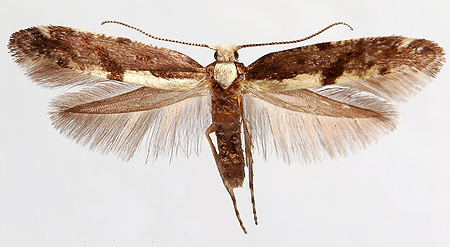Pests
Argyresthia conjugella Zeller - Apple Fruit Miner
Systematic position.
Class Insecta, order Lepidoptera, family Argyresthiidae, genus Argyresthia.Biological group.
Oligophagous pest of apple trees and mountain ashes.Morphology and biology.
Forewings violet-brownish-gray, with albesent strokes at anterior margin, white strip along posterior margin, interrupted with dark brown median band (wingspan 11-14 mm); 1-2 albesent spots just before wing tip anteriorly. Hind wings brownish-gray with a fringe of light gray long hairs. Eggs round-oval, light red, with small dark speckles scattered along surface. Caterpillar yellowish-white or reddish; head and occipital plate light brown. Pupa reddish, with long wing-shaped case. Pupae winter in two-layer cocoons in the top layer of ground, among fallen leaves and sometimes in cracks of bark. As exception, adult caterpillars winter in cocoons. Fertility is 30-45 (maximum 80) eggs on the average, potential is 200 eggs. Moth lays eggs one by one on unripe fruits of host plants, usually on pubescent parts of cups, between dried stamens and less often on ovaries. Emrional development lasts 7-16 (usually 12-13) days. Hatched caterpillar immediately enters a fruit on its shaded side, mining it first under the peel. After the first molt, it gnaws twisting holes "diving" in fruit pulp. Development of caterpillars lasts 40-50 days.Distribution.
The species occurs in Northern, Western, and Middle Europe; Asia Minor, Japan, Northern America. In the former USSR it is distributed in forest and forest-steppe zone of the European part, in Urals, Central Asia (mountain areas and foothills), Siberia and the Far East.Ecology
Monovoltine species. In spring, the start of moth flight begins at daily average air temperature +9°C, starting in mid-May (southern regions) or the end of June (northwest), lasting until the end of August. It coincides with the end of flowering of culture apple cultivars Saffron Pippin and Welsy, with appearance of ovaries in wild apples and with mass flowering of mountain ash. Mass moth flight occurs in June or 1st half of July. Moths become mature after additional feeding by flower nectar. Females live about 40 days. If wild apple trees grow with a mountain ash in a forest, then (at increase of the Apple Fruit Miner population density) moth migration to cultural gardens becomes slower. Fluctuations of population density by years and periodicity of the miner outbreaks in orchards depend on a series of factors, such as yield of apples and mountain ashes, conditions of the pest wintering, degree of soil humidity in a garden during moth flight, and diseases. Heavy rains, cold snaps, and frosts negatively influence the species population density. Late apple varieties are damaged most. After feeding, the caterpillars go down along silk thread to the ground, where they pupate in September or the beginning of October. Parasite Microgaster polita Mrsh. considerably reduces number of caterpillars; predatory beetles Carabus nemoralis Mull., Ophonus pubescens Mull., Amara communis Zanz. etc., and also microsporidia Thelohanla argyresthiae and a virus of nuclear polyhedrosis reduce number of pupae.Economic significance.
Sometimes strongly damages apple, yield losses may exceed those caused by the codling moth. Larvae meet also on mountain ash, plum, cherry, bird cherry, and hawthorn. The main host plant is the mountain ash. It's affected fruits can be recognized by premature reddening. As a rule, after damaging one fruit, caterpillar passes to the next one. Other trees and bushes are populated less often, mainly when mountain ash has weak fruitage. Caterpillars frequently meet on apple in the last decades, causing large economic losses. Affected fruits are distinguished first by a wormhole; later their peel turns pale and wrinkled, covered with brown speckles and small wounds. Wormholes in pulp of a fruit grow brown, sometimes reaching the seed chamber. One apple can contain as many as 25 caterpillars. Control measures are as follows: Agronomical include autumn interrow treatment of ground in gardens in order to destroy pupae, thinning of tree crowns. Biological include application of microbiological preparations. Chemical methods include insecticide treatment of fruiters after flowering; i.e., during mass abscission of petals, in order to kill adults and repeated in 12-15 days treatment during larval hatching in the centers populated by the pest. Monitoring is possible by use of sex pheromone traps.Reference citations:
Belosel.skaya, Z.G. 1963. Argyresthia conjugella Zell. (Lepidoptera, Hyponomeutidae) as a pest of apple trees and mountain ashes. Entomologicheskoe obozrenie. 42 (4): 709-720 (in Russian).Gershenzon, Z.S. 1974. Family Argyresthiidae. In: Vasil.ev, V.P., ed. Pests of agricultural crops and forest plantations. V.2. Arthropods. Kiev: Urozhai, p. 234-235 (in Russian).
Gershenzon, Z.S. 1974. Yponomeutidae, Argyresthiidae. In: Puchkov, V.G., ed. Fauna of Ukraine. V.15 (6). Kiev: Naukova Dumka, 132 p. (in Ukrainian).
Mirzoyan, S.A. & Grigoryan, A.Dzh. 1990. Apple Fruit Miner and its control. Erevan: AN Arm.SSR, 69 p. (in Russian).
Sinev, S.Yu. 1994. Family Argyresthiidae. In: Kuznetsov, V.I., ed. Insects and mites . pests of agricultural plants. V. 3 (1). Lepidoptera. St. Petersburg: Nauka, p. 254-259 (in Russian).
Vasil.ev, V.P. & Livshits, I.Z. 1984. Pests of fruit crops. Moscow: Kolos, 399 p. (in Russian).


